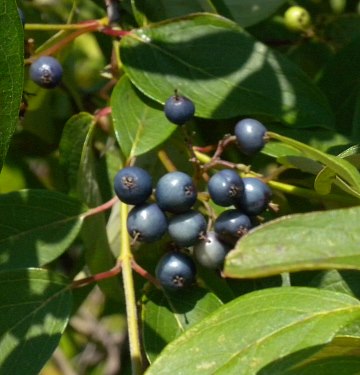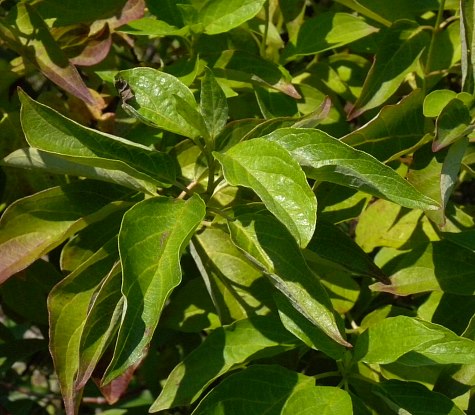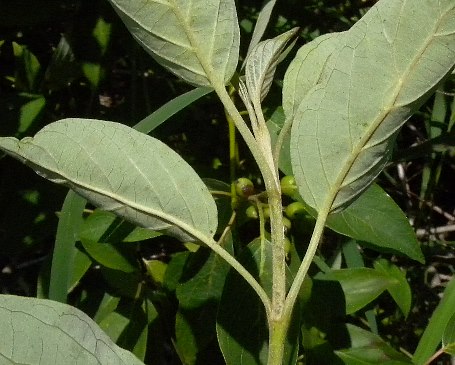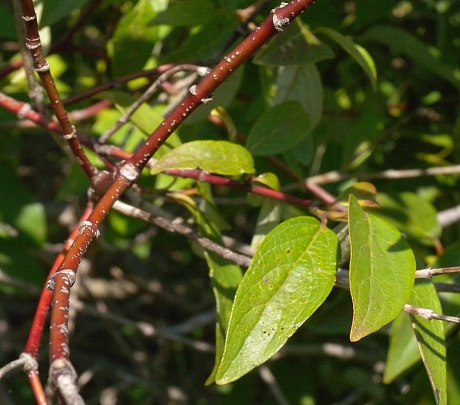
Flat-headed panicles of flowers occasionally develop among the upper branches and leaves, spanning about 2-3½" across. Individual flowers are about ¼" across, consisting of a short tubular calyx that is light green, 4 spreading white petals that are lanceolate, 4 stamens, and a pistil. The peduncles and pedicels of each panicle are light green to yellowish brown and either glabrous or covered with minute hairs. The blooming period occurs from late spring to mid-summer. The flowers have a sweet fragrance. Afterwards, the flowers are replaced by one-seeded globoid drupes about 1/3" (8 mm.) across; they become blue during the autumn and their interior is fleshy. The woody root system is shallow and spreading.
Cultivation: The preference is full or partial sun, wet to moist conditions, and either sandy or non-sandy soil that contains significant organic matter.
Range & Habitat: The native Swamp Dogwood is occasional throughout Illinois (see Distribution Map). Habitats include openings in moist woodlands, swamps, soggy thickets, wet prairies, edges of marshes, fens, and interdunal wetlands. While interdunal wetlands are always sandy, the remaining habitats can be either sandy or non-sandy. Occasionally this shrub is cultivated as a landscape plant, but it requires more moisture than most cultivated shrubs.

Faunal Associations: The nectar and pollen of the flowers attract many insects. These floral visitors include honeybees, bumblebees, little carpenter bees (Ceratina), cuckoo bees (Nomada), Halictid bees (including green metallic bees), masked bees (Hylaeus), Andrenine bees (include the oligolege, Andrena fragilis), Sphecid wasps, Vespid wasps, Syrphid flies, Tachinid flies, blow flies (Calliphoridae), flesh flies (Sarcophagidae), bee flies (Bombyliidae), butterflies, and skippers (Robertson, 1929). Other insects feed destructively on the wood, foliage, plant sap, and other parts of Swamp Dogwood and other dogwood shrubs (Cornus spp.). These insect feeders include the larvae of long-horned beetles (Cerambycidae), leaf beetles (Chrysomelidae), weevils, larvae of gall flies, plant bugs (Miridae), aphids, leafhoppers, armored scales, mealybugs, larvae of sawflies, larvae of many moths, larvae of a butterfly, the Spring Azure (Celastrina ladon), and thrips. See the Insect Table for a more complete list of these species.

The fruits of dogwood shrubs are a very popular source of food for many kinds of birds, including the Wood Duck, Cedar Waxwing, Gray Catbird, Brown Thrasher, Tree Swallow, upland gamebirds, grosbeaks, thrushes, and vireos (see the Bird Table). Some birds, like the Willow Flycatcher and American Woodcock, use dogwood shrubs as protective cover in wetland areas. Mammals that feed on these shrubs include the White-tailed Deer (twigs, foliage), Cottontail Rabbit (bark), White-footed Mouse (fruits, seeds), Fox Squirrel (fruits, seeds), and American Beaver (bark, wood). The latter animal also uses the branches of dogwood shrubs in the construction of their dams and lodges (Martin et al., 1951/1961). In wetland areas, some turtles, like the Snapping Turtle, Slider, and Blanding's Turtle, may feed on their fallen leaves or fruit (Lagler, 1943; Ernst et al., 1994).
Photographic Location: A sandy marsh at the Indiana Dunes National Lakeshore in NW Indiana.

Comments: Swamp Dogwood is one of the blue-fruited species of its genus. At one time, Swamp Dogwood was considered a subspecies of Silky Dogwood and it was referred to as Cornus amomum obliqua. However, it is now regarded as a distinct species. Silky Dogwood (Cornus amomum) differs from Swamp Dogwood by having rusty hairs underneath its leaves and its leaves are usually more broad in shape. Another blue-fruited species, Stiff Dogwood (Cornus foemina), differs by having leaf undersides that are hairless and green, rather than whitened; it also differs by having hairless leafy shoots and white pith in its twigs. Alternate-leaved Dogwood (Cornus alternifolia) has drupes that are blue-black; it differs from Swamp Dogwood by having alternate leaves with slightly more pairs of lateral veins (4-6), a more tree-like habit of growth, and twigs with small white pith. Another commonly used name of Cornus obliqua is Pale Dogwood.